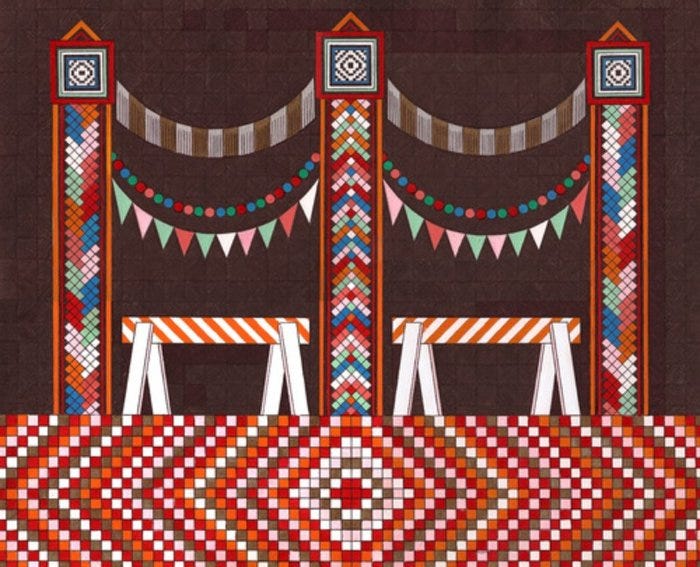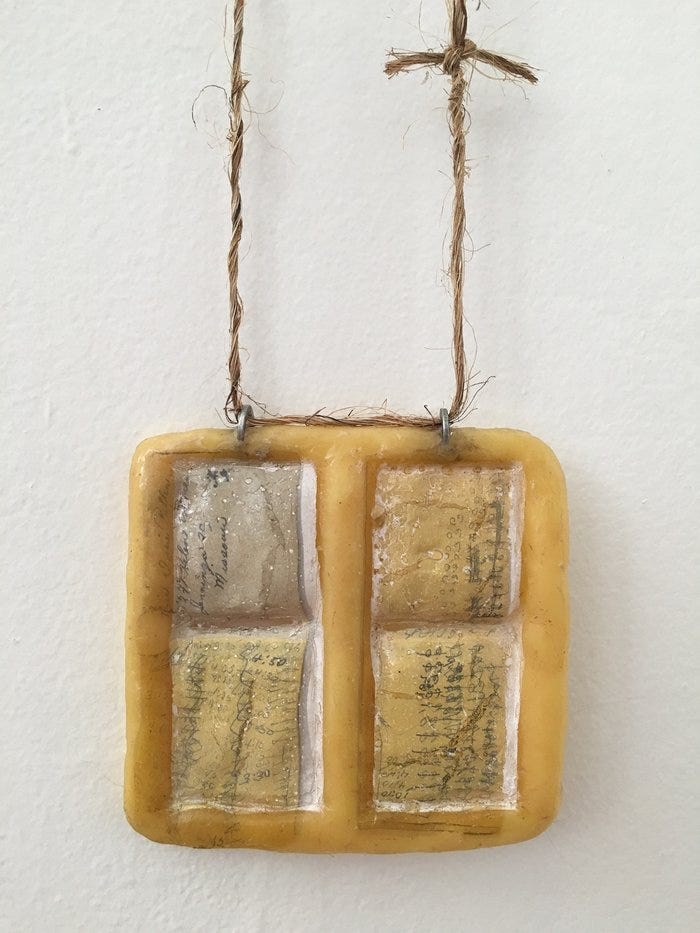
10/23/20
I've always been obsessed with patterned textiles, wallcoverings, and tiles. Now, I'm thinking a lot about how artists use pattern in their work. ArtWrite featured three of these artists this week: Aliza Nisenbaum, Daisy Patton, and Edie Fake, whose dazzling images open and close this issue. Fake's work comes from his 2012 show, Memory Palaces. You can see their work and the writing it inspired here.
This week's interview is with two artists in their early 20's, Sasha Miasnikova, whom I taught at Packer Collegiate in Brooklyn, and her friend, Tulane Eichhorn. Their work also appeared this week on ArtWrite.
When I first taught Sasha in the 8th grade, she had already established a reputation as a gifted artist. I understood why her teachers and classmates were in awe of her talent when I saw her final project for the graphic novel MAUS. Sasha's drawing skills and use of the cartoon techniques the class had been analyzing were incredibly sophisticated.
I taught Sasha again when she took my memoir elective in high school. She was a junior and on the fence about art school vs. a liberal arts college. In her writing, Sasha explored the burden of her talent. She'd begun taking adult art classes as a young child, and at only 17, was struggling to find pleasure in her work.
Since then, whenever I asked someone about their experience of becoming an artist, I wondered about Sasha. Had she reconciled her dilemma? Was she still making art? I tracked her down and was happy to learn that she is studying at the School of the Art Institute of Chicago (SAIC). As I was interested to know what it's like to be a young artist in art school, I asked Sasha if I could interview her and a classmate.
A lot of the conversation with Sasha and Tulane pointed to the value of having a community. SAIC provides students with the opportunity and facilities to explore a range of media. Still, feedback, encouragement, role models, and networking opportunities from peers and professors emerged as an even more compelling reason to attend art school.
I wasn't surprised. When I got my MFA in fiction, I spent two years in the bubble of a writing community. We analyzed craft, gave each other input on our work, published a literary magazine, went to readings, and spent most of our time talking about writing. What a luxury that was.
-- Maggie Levine
P.S. If you're a recent subscriber and would like to read back issues, click here
ArtWrite Interview: Sasha Miasnikova & Tulane Eichhorn
Since COVID, you’re both taking off the semester and sharing a studio with three friends who also attend SAIC. How has that been going?
Tulane: It’s really great when I’m there with another person or two other people, and everyone’s working.
Sasha: Before Covid, I was in this advanced painting program in school, and we all shared a studio. I was used to working alongside people.
Tulane: Having a studio with other people is like going to the coffee shop to do your homework because other people are doing their homework. The atmosphere makes it so much easier to concentrate.
Sasha: Colleagues are super important. You need to have people you can talk to about your work, and if those buddies make work too, conversation comes easy. It’s like you get to skip a couple of steps because they get the process. You can meet each other on the same level faster.
The communal aspect of the studio is working for you. In what other ways do you benefit from the art school community?
Sasha: The only way you can get better is if you get other people’s input. There’s a time and place for being alone and having my blinders on, but you have to see what others are doing. It makes you stronger. In the studio, we’re essentially mimicking what class is, little 15-minute meetings with your peers and teacher, asking: “What do you think of this?” Like a crit.
Tulane: Being around experienced artists is important, and art school can facilitate those relationships. Because I’m not in school right now, I really don’t interact with anyone over 25. That’s been fun, but I’m seeing that there is this wisdom we’re lacking because we’re all in the same age group and have the same level of experience.
Sasha: All the professors are practicing artists. If one of your friends has a class with a professor, and that weekend they have a show opening up, you can go see it. It’s encouraging to see your teachers out in the world and as regular people; it’s not just like a nine to five, and then they go home; they’re very much in the community.
Has art school changed how you see yourself as an artist?
Sasha: It's been good for me to contextualize myself amongst present art-makers, work with professors, and learn about my peers' work and what they're into.
Tulane: It took me a long time to get comfortable with the label. It feels like there are requirements that you have to earn it, but that is just nonsense. It's been very heartening to permit myself such a romantic title.
Sasha: I didn't feel like an easy approach to the title; it was uncomfortable. I felt I hadn't matriculated into it yet.
Seeing kids my age whom I respect answer "What do you do?" with "I'm an artist," instead of saying, "I'm a student," made me be able to say it too. And it turned out to be easier to answer with "artist". It shows you the people who actually want to know about what you're doing, those who don't really care just go, "Oh, Cool."
Tulane: Being able to call yourself an artist is confidence-boosting. It almost makes me giddy. It's something I had to work up to for a long time. It's totally gratifying to say it even though nothing's really changed.
Sasha: That's the whole trick.
Tulane: It's really fake it til you make it.
Within the context of art school is there any hierarchy? Do you have to be an artist with a capital A, or do photography and digital work command the same respect as fine art?
Sasha: The way that Tulane sees art is so different than how I grew up seeing art. It’s more detached from the artworld mechanism.
Tulane: I consider the art I make to be more design-driven, craft driven. I’m more concerned with making functional art, so that is part of the detachment. I want it to be used, so I see it in a different way.
When I met Sasha, I was really starting to feel insecure. Am I really an artist? And Sasha - was like “yeah, duh.” It was very validating to talk to her about it.
Sasha: There’s always been a big discrepancy between the kind of power and weight an object holds when it’s deemed art or craft, especially in terms of monetary value; for example, something 2-D on a wall is looked at differently than something which has functional or domestic use.
Some kids at SAIC have a strict definition of what art is. I had really traditional training growing up. I’ve been unlearning it and using it at the same time; you learn how to apply the tools you have in different ways.
Anything that comes out of you that you use your hands to make is your work. It doesn’t need to be a certain material or medium.Just because I made five paintings in a row, and they’re all about this one thing, I’d get into this weird space where I thought this is who I am now. Then it’s really hard to get out of that because that’s what I think I make.
Tulane: Naturally, the stuff you make will bear some resemblance to previous work, but I think it’s so healthy for artists to make things that don’t fit into their normal MO, their vibe, their theme, or their subject matter.
Sasha: But it doesn’t have to fit a specific aspect ratio for it to be “this is a painting I made.” I can make a candle and have it be Sasha’s work. It doesn’t have to be presented in a certain package the way I used to think it did.
Tell me what you're working on right now.
Tulane: Right now fiber crafts feel so right. The plush dolls I have been making are hand-sewn and embroidered, often with a functioning satchel that holds aromatic herbs or a special stone. Each one is made especially for the person commissioning it. They are very intimate; some of the most fulfilling work I’ve made. I’ve made a total of eight dolls so far and am feeling a bit restless. I am ready to start a new project. Quiltmaking is my new obsession and I hope to jump into that very soon.
Sasha: I’m trying to work large now that I have the capability for it and comfortable storage. I don’t have to worry about transportation before I even make the thing, which is awesome. I’m working at multiple pieces at once, jumping around based on what interests me that very morning, trying to make the process more open. Making drawings, wax tablets, more interesting surfaces/supporting structures for paintings. Hopefully trying to get a hydro printing setup going in the studio, a process I learned about this summer. I’m excited!
When you think about being an artist in the future, what thoughts come up?
Tulane: I’ve been making dolls recently. I’ll Facetime Sasha, and she’ll be lying in bed, cuddling the doll that I made. I can’t imagine a better feeling than having someone utilize something I made and love something I made, naming it, and having it be a part of their life. That is the ultimate goal for me.
Sasha: My hope looking forward is that I’ll still be making art; not that I ever think that I won’t make it, but it takes a lot of physical and emotional energy for me to make something, so I hope that I’ll still be doing it and that it’s making me happy.
Everyone thinks about money, obviously. I’m comfortable having a coffee shop job and making work, whereas someone else might see that as a sign of failure. I’m more scared of getting to the place where I make work just to sell it.
Tulane: Really, I didn’t know that about you.
Sasha: I had a class where the teacher asked us to go around the room and say our ideal price for selling a piece. It was a crazy realization to think that I could get to a point where I could make a painting and see a number attached to it.






